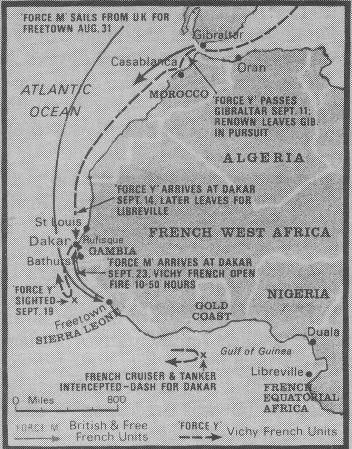- Author
- Gregory, Mackenzie J.
- Subjects
- Occasional papers, Naval Engagements, Operations and Capabilities, History - WW2, WWII operations
- Tags
-
- RAN Ships
- HMAS Australia II
- Publication
- December 1993 edition of the Naval Historical Review (all rights reserved)
Shortly after taking over the patrol off Dakar AUSTRALIA went to action stations. The reason was soon apparent – three cruisers of the French ‘Galissoniere’ class were in sight. These were 6 inch cruisers, each carrying 9 x 6 inch guns in triple turrets, 8 x 3.5 inch AA guns, 8 torpedo tubes in 4 twin mountings. Each ship was fitted with a catapult, for use by 4 aircraft.
Reported speed was in excess of 32 knots. The aircraft were recovered by a unique method. A type of steel mesh was lowered out of the square stern. This sloped down to the water, the aircraft landed, and taxied onto the screen, and a crane hoisted the aircraft aboard.
We needed to prevent the French cruisers from reaching Dakar, and CUMBERLAND joined us as we shadowed them from ahead. They continued on a southerly course. At 1730 we closed the cruisers for night shadowing. Night fell quickly as it does in the tropics and the French ships turned to the north-west and increased speed. They were soon out of sight, as we worked up speed to give chase.
A heavy cruiser takes time to work up speed. Not at all like putting one’s foot down on a car accelerator, and getting a quick response. At 2100 we sighted one of the French men on our starboard bow.
Our capture: the GLOIRE, who had broken down and could now only proceed at 4 knots.
CUMBERLAND and DEVONSHIRE were after the other two French cruisers who subsequently reached Dakar, having proved too fast for the British ships. During the chase AUSTRALIA reached 32.8 knots, needing 82,000 horsepower to achieve this speed. The ships designed horsepower was 80,000 and we were over 6 months out of dock with a fouled bottom and well above her 1928 designed tonnage. Praise was due to the engine room staff who kept the ship steaming at full speed, under most difficult conditions for almost three hours. GLOIRE was kept in sight all day, and could now steam at 20 knots. She was instructed to proceed to Casablanca, and warned we would sink her if found in the vicinity of Dakar.
We parted company and proceeded to the west. Our captain now outlined the operation to the ship’s company. The battleships, BARHAM, RESOLUTION with AUSTRALIA, are to be the bombarding ships. ARK ROYAL will use her aircraft for reconnaissance, and for bombing if force is needed. Destroyers will screen the force, and the troopships have DEVONSHIRE to escort them. The plan was for the French airmen to fly off ARK ROYAL and land at Dakar, and try and win the air force over to de Gaulle.
Aircraft from ARK ROYAL were to fly over Dakar and drop leaflets explaining the situation, and beseeched the population to change their allegiance to Free France. If the French airmen were successful, representatives of General de Gaulle would enter the harbour in a motor boat fitted with a loud speaker. Their objective, to convince the navy to join de Gaulle. The real objective was to take Dakar, convert it, preferably without bloodshed. If this plan was not successful, French troops would attempt a landing, and try to convince the government to declare Dakar on the side of de Gaulle. Failing this move, the forts would be bombarded, and marines landed to attempt to take the town. These three plans were code named `Happy’, `Sticky’ and `Nasty’.
We joined the fleet, with the troopships, and proceeded towards Dakar.
Monday, 23rd September, 1940

Dakar lay on the flank of the long supply route via the Cape of Good Hope to the Middle East, India, and the Far East
The day dawned very hazy, with visibility no more than a mile and a half. The French aircraft flew off the ARK ROYAL and landed at ‘Wackem’ aerodrome at Dakar. They signalled `success’- propaganda leaflets were dropped over the town by fleet air arm planes. General de Gaulle’s representatives in their motor boat entered Dakar harbour.




